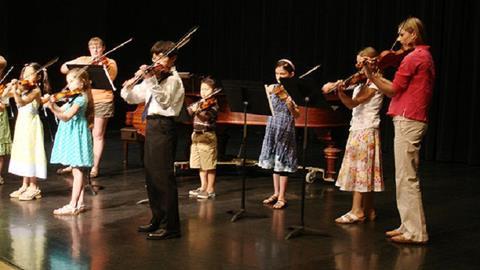The University of Hartford Suzuki Department chair shares her methods for teaching children

Encourage parental involvement
I ask all potential students and their parents to observe six beginner-level lessons before they start. This way the child and the parents can see what will be required of them, and I can judge whether the child has the ability to focus for a half-hour lesson. In the Suzuki method, parents come to lessons, take notes, participate verbally in the assessment process when asked, and become the home practice assistant. Because they are so involved in the learning process, I find they are also committed in other areas, and are happy to help with moving chairs for rehearsals, preparing refreshments, scheduling outreach performances and more.
Introduce notation at an early stage
I teach the names of the notes from the very beginning and ask my students to spend time listening to the CDs that accompany the Suzuki tutor books while pointing at the notes on the score. I also talk in terms of half and whole steps from the first scale they play. Since the Suzuki method is similar to learning a language, it’s important for students to learn to play with a solid technical foundation first (speaking), before introducing reading – as we do with our native tongue.
Drawing notes on lines and spaces, adding clefs, and recognising notes are all done in the early stages of the second Suzuki tutor book. Since most of my students start at the age of four, they are around six when they reach this. Reading must be done on a daily basis at home, and as a teacher it is my responsibility to make it part of every lesson. I am passionate about my students learning to read well. I adore chamber music and orchestral playing and want the same for my students.
Give detailed instructions for practice sessions
One of the biggest responsibilities a teacher has is to teach their students how to practise. Telling them what to practise will not further their knowledge – you have to get them to do what you want in lessons first. I mostly work with pre-college students and I am very detailed about their practice. I ask them to repeat troubled spots until I see the change that I want to see. Then I assess their understanding of whether or not the change has been made and how they made it. With my younger students, I give a specific number of times to repeat each thing. The length of practice will vary from student to student and depending on their commitment level, but the common denominator has to be that practice is regular and consistent.
Include ensemble playing as part of the learning process
Ensemble playing is essential for all levels. Even in the earliest Suzuki group classes, I teach ensemble skills to children as young as three – sometimes without playing a note. Activities that involve building and solidifying the inner pulse are the first steps towards successful ensemble playing. Students should always play at a level that allows them the freedom to learn and implement the skills needed for enjoyable and productive participation. Often students are over-challenged by music beyond their technical level, so the rewards of ensemble playing are never realised.
Only introduce vibrato once the basics have been mastered
When to introduce vibrato depends on the child. Generally, I look for good posture and a relaxed and well-developed right and left hand before approaching vibrato. In addition, the student must have consistent intonation and mastery of several keys, including F major and D minor. The backwards extension of the B flat and F natural can affect intonation if not taught properly or monitored.
Always foster a love of music
I want my students to find a love and respect for music, and to realise that the rules of learning an instrument apply to all aspects of life. Having a goal, breaking it down into small steps and accomplishing each one before moving on to the next is the basis for successfully surviving life.
This article was first published in The Strad's February 2012 issue.
Read: ‘Inherently democratic’ - equity and the Suzuki Method
Read: ‘Planting seeds for my relationship with music’ - Hilary Hahn and the Suzuki method










































No comments yet